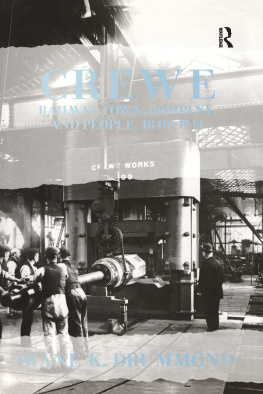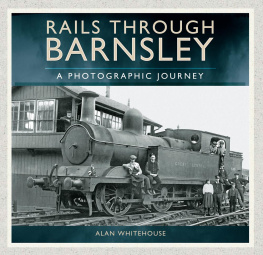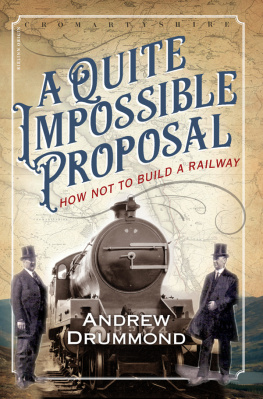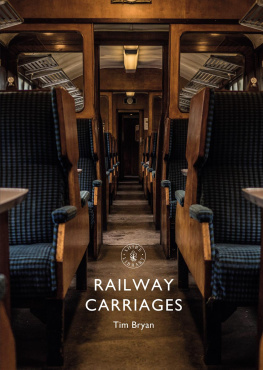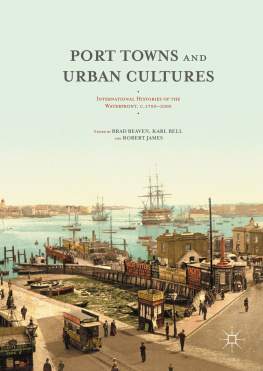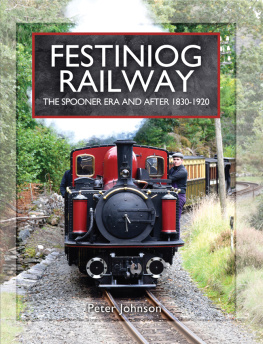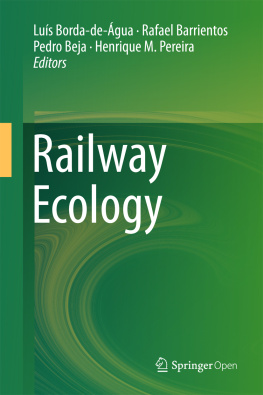Crewe: Railway Town, Company and People 18401914
Crewe: Railway Town, Company and People
18401914
DIANE K. DRUMMOND
First published 1995 by Scolar Press and Ashgate Publishing
Published 2017 by Routledge
2 Park Square, Milton Park, Abingdon, Oxon OX14 4RN
711 Third Avenue, New York, NY 10017, USA
Routledge is an imprint of the Taylor & Francis Group, an informa business
Copyright Diane K. Drummond, 1995
All rights reserved. No part of this book may be reprinted or reproduced or utilised in any form or by any electronic, mechanical, or other means, now known or hereafter invented, including photocopying and recording, or in any information storage or retrieval system, without permission in writing from the publishers.
Notice:
Product or corporate names may be trademarks or registered trademarks, and are used only for identification and explanation without intent to infringe.
British Library Cataloguing-in-Publication data
Drummond, Diane K.
Crewe: Railway Town, Company and People,
18401914
I. Title
942.71208
Library of Congress Cataloging-in-Publication Data
Drummond, Diane K.
Crewe: railway town, company and people, 18401914/Diane K. Drummond.
p. cm.
ISBN 1-85928-020-X
1. Crewe (Crewe and Nantwich, England)History. 2. Railroad equipment industryEnglandCrewe (Crewe and Nantwich) History. 3. Locomotive worksEnglandCrewe (Crewe and Nantwich)History.
I. Title.
DA690.C78D78 1994
Typeset in 10pt Sabon by Photoprint, Torquay, Devon.
ISBN 13: 978-1-85928-020-1 (hbk)
In memory of my mother Irene Clark, 19251983
Contents
In Appendices
Appendix 1 The Railway Town
Appendix 2 Company and Works
Number of men employed at Crewe Works, 18671914
The occupational structure of Crewe Works, 18841911
The strength of trade unionism in Crewe, 18501911
Steam-Engine Makers Society membership levels in different workshops, 1884
The occupations of fathers and sons in Crewe, 1881
Appendix 3 Railway Town Politics
Analysis of the occupational structure of voters at the Crewe Works, 1885
Occupational groups as a percentage of the division and borough electorate, 1885
All published with kind permission from the National Railway Museum, York.
| ASE | Amalgamated Society of Engineers |
| ASCJ | Amalgamated Society of Carpenters and Joiners |
| ASRS | Amalgamated Society of Railway Servants |
| BLEPS | British Library of Economic and Political Science |
| BRA | Blue Ribbon Army |
| CC | Crewe Chronicle |
| CG | Crewe Guardian |
| CME | Chief Mechanical Engineer |
| FSIF | Friendly Society of Iron Founders |
| GJR | Grand Junction Railway Company |
| GRWU | General Railway Workers Union |
| GWR | Great Western Railway Company |
| JP | Justice of the Peace |
| JSEM | Journey Steam Engine Makers Society |
| ILP | Independent Labour Party |
| LMS | London, Midland and Scottish Railway |
| LNWR | London and North-Western Railway Company |
| LRC | Labour Representation Committee |
| MI | Mechanics Institute |
| MP | Member of Parliament |
| NEL | National Education League |
| NLF | National Liberal Federation |
| NRM | National Railwy Museum |
| NRL | National Reform League |
| NRU | National Reform Union |
| NUR | National Union of Railwaymen |
| SA | Staffordshire Advertiser |
| SEM | Steam Engine Makers Society |
As a child growing up in the railway town during the 1960s, I was always fascinated by Crewes famous railway workshops. Although we lived some two miles away from the Works, their second lunch-time buzzer marked the end of play for me and return to afternoon school. In the town itself tall brick walls, often spiked with broken glass, presented an intriguing barrier between the male, industrial environment of the Works and railway, and the life of the town where the women and children of Crewe had an almost separate existence. In later years my fathers work as Crewes Amalgamated Engineering Unions branch secretary, together with school visits to the Works, brought a closer contact with this unknown world of work. This book, however, is not written out of a concern with my home towns work and politics (I was actually born in Chesterfield in Derbyshire), but the realization that Crewes near uniqueness makes it an ideal case study for examining the nature of work, society and politics during the 19th century.
Many thanks and acknowledgements deserve to be made. This book is drawn from my PhD thesis research which was undertaken in the History Department at Bedford, later Royal Holloway and Bedford New College, the University of London, while in receipt of a postgraduate grant from the Economic and Social Research Council. I cannot thank my joint supervisors, Dr John Turner and Dr Penelope Corfield enough, especially Dr Corfield for her care and understanding in dealing with another Northern lass and her strange cultural norms! Without my supervisors attention I doubt if the thesis would have been written, let alone the book. Thanks should also go to Drs Crossick and Thane for their encouragement. Some further aspects of work were carried out while I was a British Academy Post-Doctoral Fellow at Royal Holloway and Bedford New College. Dr Charles Harvey should also be mentioned in regard to the Crewe Works employees register database. A note of thanks should also be made to Dr Terry Gourvish who published my article on Building a Locomotive in the Journal of Transport History. Thanks also to Dr Charles More for his encouragement especially during my year impersonating him (with my accent I did it very badly), at Cheltenham and Gloucester College of Higher Education when he was on sabbatical. Various seminars held over many years at the Institute of Historical Research, the Economic History Society, at the University of Bristol, Royal Holloway College and the University of Birmingham also aided thought. Lectures and papers given in Crewe, at the Local Historical Society, and to the London and North-Western Railway Society (1993) were also very stimulating, as some of the texts endnotes will testify. As is usual in prefaces of new books, I would like to point out that any mistakes of logic and text are purely mine!
In Crewe itself I must thank Mr Peter Ollerhead, a longstanding friend and expert on the towns glorious (if a little dour) nonconformity. Much of the information used in my chapter on local nonconformity is drawn from Peters thesis, a fact which needs to be duly acknowledged. Mrs Alyson Tagg also supplied some further information. Another more unusual acknowledgement goes to Crewe Heritage Centre, Mr Peter Barnard and the Exhibition Team of 198687. Working to set up an exhibition about the history of Crewe gave me the opportunity to both meet more people of the railway town and to see how they reacted to their history, a story which some seem to regard as being hardly old enough to be history at all until recently. My thanks to those members of the public who shared their memories and some of their treasures with us for the exhibition.

